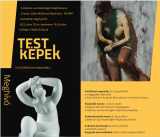Tibor Csernus's painting in the 1980s turned to the old masters, providing a contemporary interpretation of their technique. In its theme, it harks back to prefigures, but freely selects and arranges characters from mythological and biblical stories into one scene. The painter did not moralize, the subject served only as a way to stage human figures and show their relationships. His nudes and study drawings are not simple prefigures, but often visual outgrowths of an idea from various aspects. Seemingly unfinished details, improved surfaces, impatient-looking paint pulls are placed one above the other on the canvas, and their expressiveness suggests haste, but in fact they are the result of ever slower, more thoroughly matured work.
Boldi's sculpture is similarly naturalistic, focusing on man and the human body. He brings all this into dialogue with the closed forms of marble or bronze castings with a special patina . The clear modern language of humanity, built on classical sculptural traditions and reduced to basic forms, makes his creative way of thinking akin to the painting of Csernus. In Boldi's case, the question of morality already appears, but his nudes are presented as symbols, and thus problems can be explored literally through the series of works. The sculptor approaches the human body with restraint, building on its meaning-bearing qualities rather than its staged, expressive character.
The permissive softness of the paint contrasts with the inexorable rigidity of the stone. The intersection of the form language of the two artists, which at first seems opposite, can be found in the transformation of the artistic qualities formulated and researched in them into images and figures.

